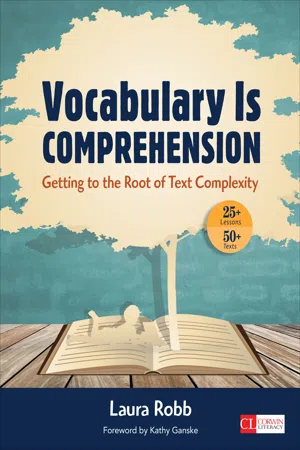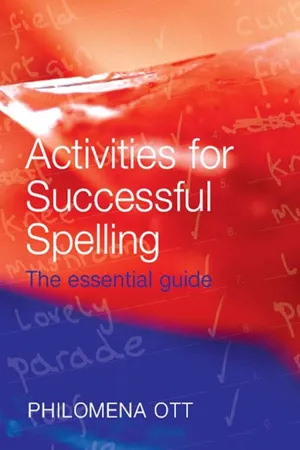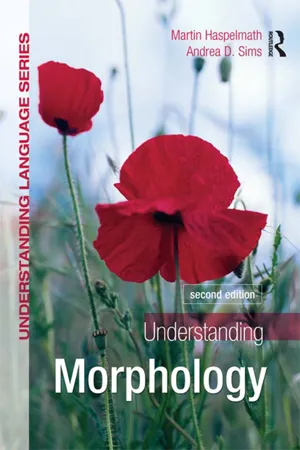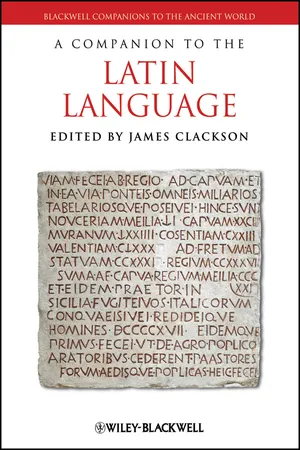Languages & Linguistics
Latin Roots, Suffixes and Prefixes
Latin roots, suffixes, and prefixes are fundamental components of many words in the English language. Latin roots provide the core meaning of a word, while suffixes and prefixes are added to modify the meaning or create new words. Understanding these elements can help in deciphering the meanings of unfamiliar words and expanding vocabulary.
Written by Perlego with AI-assistance
Related key terms
Related key terms
1 of 4
Related key terms
1 of 3
8 Key excerpts on "Latin Roots, Suffixes and Prefixes"
- eBook - ePub
- Philomena Ott(Author)
- 2014(Publication Date)
- Routledge(Publisher)
11 How Affixes Provide Signposts and Enhancement of Skills DOI: 10.4324/9780203966075-11- Why the study of the history of words is a key to a treasure trove of spelling knowledge and understanding
- Why root words are important basic building blocks for word study
- Checklists of useful root words
- Prefixes: an overview
- Checklist of prefixes
- Practical suggestions for teaching prefixes
- The role of grammar and its influence on suffixes
- Checklist of suffixes
- The ‘Seven Seriously Super Suffixing’ rules
- The ‘Seven Absolutely Fabulous’ rules for suffixes
- Practical suggestions for teaching suffixes
- Summary and conclusions
KEYWORDS
- Affixes
- Analytic phonics
- Antonyms
- Borrowed words
- Comparative forms of adjectives
- Euphony
- Etymology
- Grapheme
- High-frequency word
- Morpheme
- Morphology
- Phoneme
- Prefixes
- Root words
- Spelling pronunciation
- Suffixes
- Synthetic phonics
- Word class
- Word webs
Why the study of the history of words is a key to a treasure trove of spelling knowledge and understanding
Awareness of the etymology of words, which includes the study of the origins and use of Greek and Latin prefixes, suffixes and root words, enhances skills, promotes understanding of word meanings and generates many new words.Root words cycl (circle) Greek bicycle loc (place) Latin locate Suffixes ology (study of) Greek biology phobia (excessive fear of) Latin arachnophobia (fear of spiders) Prefixes anti (against) Greek antibiotic circa (around) Latin circulation Understanding of the derivation and meaning of affixes and root words makes them easier to learn to pronounce, to spell and to remember. Brown (1947) established that 60 per cent of words in printed texts were derived from Latin and Greek words. Otterman (1955) conducted an experiment on 12–13-year-olds which included learning about word origins. After thirty ten-minute lessons, the pupils were better at spelling and understanding the meanings of the words when they had been taught the meaning and the derivation of the words studied. Hanna et al. (1971) - eBook - ePub
Vocabulary Is Comprehension
Getting to the Root of Text Complexity
- Laura J. Robb(Author)
- 2014(Publication Date)
- Corwin(Publisher)
, suffixes, and roots to decode compound and multisyllable words.What the Common Core State Standards Have to Say
The Common Core Vocabulary Standard 4b states, “Use common, grade-appropriate Greek or Latin affixes and roots as clues to the meaning of a word.” Studying roots and affixes across the curriculum is an efficient way to enlarge students’ vocabulary. The study of one root along with prefixes and suffixes can lead to an understanding of 10 or more words related to that root.In Standard 6, the Common Core requires that students “acquire and use accurately grade-appropriate general academic and domain-specific words and phrases.” By building words using Greek and Latin roots, prefixes, and suffixes, students can improve their comprehension of academic vocabulary and develop fluency with 90 percent of the words that appear in texts for Grades 3 to 9 (Blachowicz, Fisher, Ogle, & Watts-Taffe, 2006; Berne & Blachowicz, 2009; Kieffer & Lesaux, 2007; Rasinski, Padak, & Newton, 2008).Ultimately, improved general academic and domain-specific vocabulary leads to students’ ability to read and comprehend grade-level complex texts. The most effective way to teach vocabulary is to select and teach roots that relate to topics in English, social studies, science, and mathematics. In this chapter, I show you how to go about this word study systematically, with the 10- to 15-minutes-a-day approach outlined in previous chapters.Definitions to Share With Students
Prefix: A prefix is a letter or a small group of letters that have meaning and are attached to the beginning of a word. Prefixes change the meaning of a root or a base word. For example, connect is a base word that means to join; add the prefix dis—disconnect - eBook - ePub
Activities for Successful Spelling
The Essential Guide
- Philomena Ott(Author)
- 2012(Publication Date)
- Routledge(Publisher)
Understanding and recall of keywords are significant factors for successful work on syllables. They can be established by using different strategies and a variety of tactics depending on preferred learning style. Many dyslexic learners have difficulties with word retrieval and word naming, so it is essential that teacher/learning partner and learner constantly revise and rehearse keywords, such as short and long vowel, consonant, blend, digraph, affix, root word, prefix, suffix and antonym. The teacher/learning partner and learner can discuss the aim of each activity, then review the list of keywords and look at the given examples. Further examples may be generated and these can be written on the board, on an overhead transparency (OHT) or on an interactive whiteboard to provide a computer printout. This can be filed in a personal ‘Spellofax’ for review and revision. Dictionary work will also play an important role as learners study meanings, derivations and the use of words.Aim: To identify, understand and use words with Latin rootsChecklist of useful Latin root words Word list based on The National Literacy Strategy Key Stage 2 Spellingbank (DfEE, 1999) The examples were chosen to show the use of both prefixes and suffixes, rather than listing every possibility.Keywords to review: A root word is the main part or stem of a word. It can take a prefix or suffix:
First, you need the checklist of useful Latin root words in front of youport er report er deport ed - look at each word
- say the word
- learn its meaning
- read the examples
- highlight the root word within each example
Using Latin root wordsChecklist of useful Greek root words Word list based on The National Strategy Key Stage 2 Spellingbank (DfEE 1999) The examples were chosen to show the use of both prefixes and suffixes, rather than listing every possibility.- look at each word
- say the word
- highlight the root and say its meaning (you can use a dictionary)
- copy out the word
- use it in a sentence
- use the proof-reading C-O-P-S
ACTIVITY Aim:To identify, understand and use words with Greek rootsKeywords to review: A root word is the main part or stem of a word. It can take a prefix or suffix:Using Greek root words
First, you need the checklist of useful Greek root words in front of youport er report er deport ed - Look at each word
- Say the word
- Highlight the root word say its meaning (you can use a dictionary)
- Copy out the word
- Use it in a sentence
- use the proof-reading C-O-P-S
Section A- have the checklists of Latin and Greek roots in front of you
- fill in the missing letters (below) to complete the word
- then make a sentence for each word
Section B – Quiz 1 Complete the quiz by using words from the Latin and Greek root checklists1. The name of an American political party. At one time Bill Clinton was one of the best known members of the . . . . . . . . . . . . . . . . . . party. - eBook - ePub
- Alex Quigley(Author)
- 2018(Publication Date)
- Routledge(Publisher)
With a little support and imagination, children can be recognising patterns in everything they read, from academic textbooks to comic books. From connecting words within subjects, to coining wholly new words, the limits are endless. Such knowledge of language becomes a new way of thinking and powerful knowledge indeed. Unfamiliar words can become familiar; new words connect to old, with vocabulary and understanding developing in tandem.We need to dispel the myth that the study of etymology and morphology is only the preserve of the English language or modern foreign language teacher. We need to dispel the myth that the Latin and Greek roots of our language are only for nice, but intermittent enrichment activities for a select few privileged children. Our approach to the roots of language can be systematic and developed through our school curriculum. In so doing, we could address many related issues, like spelling problems (more on this in Chapter 6 ), whilst developing a broad and deep vocabulary that gives children the tools to access a challenging academic curriculum.It is clear that looking to the language of our past helps us to best prepare our children for the future.IN SHORT…• When it comes to vocabulary knowledge and school success, ‘word depth’ is probably more important than the breadth of our vocabulary.• Over 90% of the vocabulary of academic texts in school has Latin and Greek origins and therefore teaching etymology has positive implications for learning and cracking the academic code of school.• We can encourage ‘word consciousness’ in our classrooms, fostering a curiosity and interest in words that sparks deep, rich learning.• The study of morphology – word parts – is a proven method to enhance reading comprehension (even when learning additional languages). We can better understand academic vocabulary by recognising their common word parts, beginning with word roots then moving onto prefixes.• - eBook - ePub
- Martin Haspelmath, Andrea Sims(Authors)
- 2013(Publication Date)
- Routledge(Publisher)
bound stems.Roots and affixes can generally be distinguished quite easily, but sometimes there are problems. For example, the Salishan language Bella Coola has a number of suffix-like elements that do not seem to have an abstract meaning (see 2.8). In (2.9), we see two examples of how these elements are used.(2.8) -us ‘ face’ -lik ‘ body’ -an ‘ ear’ -altwa ‘ sky, weather’ -uc ‘ mouth’ -lt ‘ child’ -aɬ ‘ foot’ -lst ‘ rock’ -ak ‘ hand’ -l s ‘ nose’
(Mithun 1998: 300–5)(2.9) a. quć -aɬ -ic wash-foot-I.him ‘ I am going to wash his foot’ (lit.: ‘ foot-wash him’ ) b. kma-l s-c hurt-nose-I ‘ my nose hurts’ (lit.: ‘ I nose-hurt’ ) In these cases, it is not immediately clear whether we are dealing with suffix–root combinations or with root–root combinations, i.e. compounds. The elements in (2.8) do not occur as lexemes by themselves but must always be combined with other roots. In this respect they have a property that is typical of affixes, and scholars of Salishan languages have generally regarded them as such. However, if affixes are defined as ‘ short morphemes with an abstract meaning’ , then these elements are very atypical affixes, to say the least.English has a number of morphemes that are similarly difficult to classify as roots or affixes. Some examples are given in (2.10). - eBook - ePub
- James Clackson, James Clackson(Authors)
- 2011(Publication Date)
- Wiley-Blackwell(Publisher)
CE . Etymological dictionaries of Latin include Ernout and Meillet (1979), Walde and Hofmann (1969) and de Vaan (2008); Benveniste (1969) is also useful for tracking IE origins of Latin vocabulary relating to specific social institutions, and Maltby (1991) records ancient etymologies. Latin borrowings from Greek and from Etruscan are discussed in Biville (1990, 1995) and Hadas-Lebel (2004). There are numerous studies on selected lexical items or lexical areas in Latin, among which it is worth mentioning here Adams (1982a) on sexual vocabulary, Fruyt (2006) on colour terms, and the studies of André (1967, 1985, 1991) on birds, plants and anatomy. The vocabulary appropriate for different genres of literary composition and in technical writings are discussed in Axelson (1945), Coleman (1989a) and Langslow (2000b).Passage contains an image CHAPTER 11
Word-Formation in Classical LatinMichèle Fruyt In this chapter, we are going to look at the six main types of word-formation in Latin: suffixation, nominal compounding, verbal compounding, preverbation, agglutination and recategorisation.SuffixationLatin used suffixation for the formation of all its grammatical categories: nouns, adjectives, adverbs and verbs. Suffixation was the dominant type for nouns and adjectives. A given suffix may be considered productive in Classical Latin if there is a large number of lexemes in which it appears. If we structure the list of these lexemes in decreasing order of frequency, we will see: (a) a very high frequency for a few of the lexemes at the top of the list, and (b) a large number of hapaxes and lexemes with very low frequency at the bottom of the list.The presence of a large number of lexemes with the suffix and the very high frequency of a few of them reflect the importance of the formation in the texts, and therefore probably in speech. The presence of a large number of very low frequency lexemes provides a clue to the suffix’s potential for extension and its capacity for creating new items. Thus, for a suffix to be considered productive we also need words which are attested only once or twice, or even which are not attested at all but which are “attestable”, i.e. lexemes that have the potential to exist, since they could be coined by any speaker according to regular patterns. - eBook - ePub
The Vocabulary of Modern French
Origins, Structure and Function
- Hilary Wise(Author)
- 2003(Publication Date)
- Routledge(Publisher)
-logue, a root in Greek, patterns more like a suffix in French.13 Only a few suffixed compounds of the non-classical type exist, such as tirebouchonner and gentilhommière. Words like banqueroutier or bouleverser are former compounds whose stems have coalesced to the point of becoming single morphemes. Dauzat (1937) shows how on occasion French is obliged to borrow a derived form, owing to the difficulty of suffixing compounds; for example ferroviaire, the adjective corresponding to chemin de fer, comes from Italian.14 See Cottez’ dictionary (1988), which gives large numbers of Greek and Latin roots recurring in scientific and technical terminology; these are also classified separately according to the notions they express, so that beaucoup is shown to correspond to both Greek poly- and Latin multi-, and so on. As a number of the entries indicate, even these classical roots are subject to homonymy and polysemy, with auto-, for example, meaning ‘self (as in autofinancement, autobiographie), or ‘relating to motor vehicles’ (e.g. autocar, autoroute).PROJECTS
1 Identify the constituent morphemes of the following words as root, suffix or prefix, bound or free, and indicate the meaning or function of each, justifying your analysis where possible with reference to words similar in form and meaning:décalage, courage, carnaval, carnivore, exaucer, excaver, document, regiment, maison, livraison, champignon, champêtre, famine, gamine2 Establish lexical paradigms based on the following roots:rouge, noir, blanc, vert, pourpre, bleu pomme, olive, orange, abricot, ceriseNote parallels and discrepancies in these paradigms. Do there appear to be any lexical gaps? If so, suggest how they might be explained. - eBook - ePub
Rootedness
The Ramifications of a Metaphor
- Christy Wampole(Author)
- 2016(Publication Date)
- University of Chicago Press(Publisher)
That words whose meaning was originally sexual spread out so as to overlay meanings that are very remote doesn’t mean as a consequence that the whole field of meaning is overlaid in that way. That doesn’t mean that all the language we use is in the end reducible to the key words it contains, words whose valorization is considerably facilitated by the fact that one accepts as proven what is, in fact, most questionable, namely, the notion of a root or a radical, and what in human language would be its constitutive link to sense. This emphasis placed on roots and radicals in languages making use of inflections raises particular problems that are far from being applicable to human language universally. What would be the case with Chinese, for example, where all the signifying units are monosyllabic? The notion of root is highly tenuous. In fact, what is involved is an illusion that is linked to the development of language, of the use of the language system, which can only seem very suspect to us.Lacan, Ethics, 167Using this comparative approach, Lacan shows that this difference between Chinese and European languages refutes the notion that all languages began with elementary units that eventually clustered or burgeoned to form more complex units in time.76 Paulhan, La preuve, 18.77 Of calembours and etymologies, Paulhan writes: “D’où vient sans doute le caractère comique de telles phrases: c’est qu’elles ne tiennent pas la promesse qu’elles ont un instant paru nous faire, et ne nous offrent qu’une explication sitôt ruinée qu’ébauchée.” Ibid., 66.78 Cécile Hanania dedicated an entire book to the relationship between Roland Barthes and etymology, for example. She writes in the introduction, “Throughout his critical development and regardless of which theoretical movements one associated with him or that he belonged to, Roland Barthes appealed constantly to etymological filiations or deductions—proven or imagined—in his analyses and reflections.” Hanania, Roland Barthes, 16. In his use of the discipline, Barthes seemed to oscillate between etymologies used as a legitimate philological tools and as “etymologies constructed at the whim of imaginary and playful associations” (201–2).79 Derrida’s analysis of the pharmakon
Index pages curate the most relevant extracts from our library of academic textbooks. They’ve been created using an in-house natural language model (NLM), each adding context and meaning to key research topics.
Explore more topic indexes
Explore more topic indexes
1 of 6
Explore more topic indexes
1 of 4







